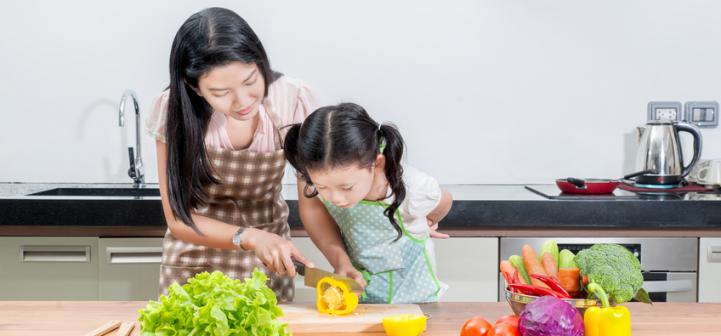
Cooking with children in schools promotes the lifetime skill of healthy cooking starting at a young age. A California Department of Education survey indicated that 87 percent of fourth to eighth graders said that they cook and make some of their meals or snacks. However, youth who lack healthy cooking knowledge may rely on packaged foods or prepared foods containing questionable nutrition value. Introducing healthy cooking in schools has many benefits:
- Children may try new and healthy foods. Recent research published in the Journal of the Academy of Nutrition and Dietetics indicates that children engaged in tactile experiences, such as handling foods, have less food neophobia (food fear) and greater acceptance of eating a variety of foods.
- A kitchen is a learning lab for children that can involve all of their senses. While kneading, tossing, pouring, smelling, cutting, and feeling foods they have fun and learn without being aware of it.
- Children who cook at home indicate a “sense of accomplishment,” self-confidence, and feeling of contributing to their families.
- They spend time cooking instead of engaged in screen time.
- Children tend to skip less healthy prepared or processed snack foods as they prepare their own food more.
- Recent research indicates that nutrition knowledge may be incomplete without the experiential learning or hands-on activities associated with food preparation that involves handling food and cooking equipment.
- Children learn lifetime skills through practicing basic math skills such as counting, weighing, measuring, tracking time; they also gain social skills by working together and communicating in the kitchen.
- Teaching cooking to youth is an opportunity to teach nutrition education such as planning meals and make smarter food choices.
- Cooking can aid children in acceptance of responsibility. Each child has a task to complete to contribute the meal preparation and cleanup.
- Cooking in schools can build positive memories that promote future healthy, enjoyable cooking elsewhere.
- Children ate more fruits and vegetables after participating in culinary classes according to some research studies.
- Many research studies show improved changes in cooking knowledge, food safety behaviors, and cooking self-efficacy.
- Other studies indicate that teaching nutrition education with food preparation in science class is more effective than in nutrition education science classes without food preparation.
Many school faculty are beginning to embrace cooking to teach and promote healthier eating. To get started in your school, below are recommended web resources about cooking programs and curriculum occurring at public schools.
Recommended Resources
Cook for Kids, Wellness in the Schools
Cooking Matters, Share Our Strength
Cooking with Kids, Illinois Extension
Teen Cuisine, Virginia Cooperative Extension
Contributor
Resources
A Call for Culinary Skills Education in Childhood Obesity Prevention Interventions: Current Status and Peer Influences, JAND: Vol.113:8, pages 1031-36.
Enjoyment of Tactile play in as associated with Lower Food Neophobia in Preschool Children, JAND: Vol.115:7, Pages 1134-1140.
Teacher Tips: Cooking with Kids, California Department of Education
The Impact of Cooking Classes on Food-Related Preferences, Attitudes, and Behaviors of School aged Children: a Systemic Review of the Evidence, 2003-2014, Prev. Chronic Dis 2014:11 140267.
Trend in US Home Food preparation and Consumption, Nutrition Journal, Vol. 12:45
